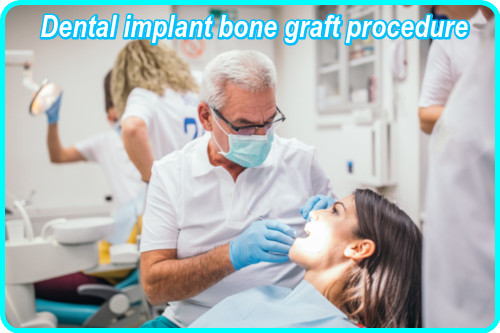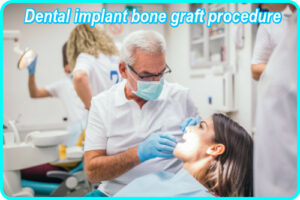Dental implant bone graft procedure
Let’s take a closer look at dental implant bone graft procedure.
In cases of bone loss in the jaw, a dental bone graft can be used to restore lost volume and density.
Bone grafts can be autogenous, meaning they come from the patient themselves, or allogeneic, meaning they come from a donor human or animal. Bone grafts are sometimes made from synthetic (alloplast) materials.
Hungarian Dental Implant Centre Wexford offer dental implant bone graft procedure at a less expensive cost compared to dental clinics in Ireland, why not book a free consultation by calling 0873490104.

What is the procedure for a dental bone graft?
When a bone graft is implanted, it creates a temporary gap in which the patient’s own healing mechanisms can take effect. A dental bone graft, then, functions similarly to a scaffold upon which new bone tissue can form and heal.
Your dentist may recommend PRP in addition to a dental bone graft in some circumstances. This is drawn from a patient’s own blood and utilized to speed up the body’s natural healing processes.
Who can benefit from a dental bone graft?
Dental implant bone graft procedure are often necessary for people who have experienced jaw bone loss. You may be advised to undergo this surgery if:
1.You need to get a tooth pulled.
2.Consider getting a dental implant to replace a missing tooth.
3.Jaw reconstruction is required prior to denture placement.
4.Suffer from pockets of bone loss caused by gum disease.
Just how prevalent are bone grafts for teeth?
Bone grafts for the mouth are very common. Any dentist, or even a periodontist or oral surgeon, can conduct these procedures.
Do bone transplants come in a variety of forms?
Yes. The four most common categories are:
Ridge preservation
Keep the socket in place. This form of graft, also known as ridge preservation, is inserted in the empty socket soon after a tooth is extracted. It works by replacing the tooth’s root and stopping the bone around the tooth socket from deteriorating.
Ridge enhancement is often part of dental implant bone graft procedure. When teeth are absent for an extended period of time, the jawbone that once supported them can deteriorate. During a ridge augmentation procedure, the jawbone is widened and/or augmented to better support dental implants or other prosthetics.
Nasal stent insertion.
The maxillary sinuses are found in the upper jaw, behind the upper teeth. If you’re missing your upper back teeth, your sinuses can move into that empty spot. The sinus membrane would need to be penetrated if implants were to be placed in this situation.
Sinus lift
A sinus lift can be performed by an oral surgeon or periodontist to solve this issue. The sinus is brought to its correct level with this treatment. The sinus is subsequently filled with bone graft material to provide a sturdy base for future dental implant placement.
Bone grafting for periodontis
Bone grafting for periodontitis. Bone that anchors teeth can be deteriorated by an infection caused by gum disease. The teeth may become loose as a result of this. An existing tooth’s movement can be decreased and its stability improved by having a periodontal bone graft implanted around it.
Dental implant placement often awaits the full recovery of a bone graft. Different people need different amounts of time to become better as part of the dental implant bone graft procedure.
Sometimes, a bone graft and dental implant can be placed at the same time by your dentist. However, each individual situation is evaluated separately.

What steps must be taken prior to receiving a dental bone graft?
Your dentist will assess the condition of your teeth, gums, and jaw during an oral examination. Bone loss can be measured with dental X-rays or CT scans. The next step is for you and your dentist to talk about possible treatments and develop a strategy to best address your concerns.
What happens during oral surgery to transplant bone?
A local anesthetic will be used to numb the region before any dental work is done. The next step is for them to make a little cut in your gums. The jawbone can be seen through a small recess created in the gums. Your dentist will next add bone grafting material to the region after thoroughly cleaning and sterilizing it.
Bone grafts are often given an extra layer of defense by having a membrane placed over them. At last, stitches are used to repair the incision and the gum tissue is realigned.
What follows a bone graft in the mouth?
Pain, swelling, and bruising are possible after a dental bone graft procedure. These are typical adverse reactions, and they should disappear within a few days. Painkillers can help with the discomfort., in some cases where infection occurs the dentist may have to prescribe antibiotics.
Over the first several days, you may see tiny bone chips emerging from the wound. Oftentimes, these bits seem like sand or salt. Call your dentist just to make sure you’re healing normally, but this is usually not a cause for alarm following the dental implant bone graft procedure.
How uncomfortable is a bone graft for teeth?
In most cases, patients undergoing oral bone grafts have minimal discomfort. Be sure to take your medication exactly as directed and pay close attention to your post-op instructions.
When getting a dental bone graft, do they put you to sleep?
Bone graft placement typically does not necessitate general anesthetic and can be performed under local. Nitrous oxide, oral sedation, and intravenous sedation are just some of the sedative options used by many dental professionals. General anesthesia may be the best choice if your situation is complex, a professional dentist will determine the best course of action.
Do bone transplants in the mouth ever fail?
The success rate of dental bone grafts is extremely high. However, as with any surgical operation, complications can arise, and smokers and persons with specific health issues are especially at risk. Dental bone transplant failure symptoms may include:
Increases in pain or swelling beyond the first week.
Drainage or pus at the site of the bone graft.
Loss of gum tissue around the teeth (also known as “gum recession”).
The size of the jaw has not increased.
BENEFITS / RISKS
What are the benefits of using bone grafts in dentistry?
The success rate of dental implants and other restorative procedures can be improved with a bone graft. After damage to the jaw, tooth loss, or periodontal disease, this operation can help you regain full function of your mouth and jaw.
Can you tell me about the potential negative effects of dental bone grafts?
Oral bone transplants have a high rate of success and minimal risk. The treatment, however, is not without its hazards.
Infection.
Heavy loss of blood.
Broken nerves.
Anesthesia-related problems.
RESOLUTIONS AND PROSPECTS
How long does it take for the jawbone to heal after a bone graft is performed?
Following the dental implant bone graft procedure and while you may start to feel better in a week or two, full recovery after a dental bone graft might take anywhere from three to nine months. The time it takes to recover from a transplant depends on a number of factors, such as the type of graft used, the location of the graft, and the patient’s own healing abilities.

When will I be able to go back to work/college?
The majority of procedures allow patients to immediately resume normal activities such as work or college. Sedation requires a slower recovery process, so you may need to plan on spending an extra day or two at home.
When will my bone graft in my jaw be fully healed?
As was previously noted, everyone heals at their own pace. Your dentist will check on your progress as you recuperate after receiving a bone graft. When your new bone is strong enough to sustain a dental implant, they will schedule your operation.
When should I make an appointment with a doctor?
Keep an eye out for any concerning symptoms after a dental bone graft has been performed. You should see your dentist if you experience:
Disabling pain.
A rise in edema. (Swelling)
Infection at the graft site (pus).
Over 101 degree fever.
Conclusion
What is a bone graft for a dental implant is essentially the loss of jawbone is damaging to oral health and can lead to a cascade of complications, including inability to chew and even tooth loss. The success rate of dental implant and bone graft procedure and other restorative operations can be increased with the use of dental bone grafts.
Dental surgery can improve jawbone health, function, and quality of life if you suspect you have lost bone tissue, the cost of dental implants will certainly come into any decision.
To find out more on dental implant bone graft procedure and where to go to save money on dental implants call 0873490104 for more information.
References
.
